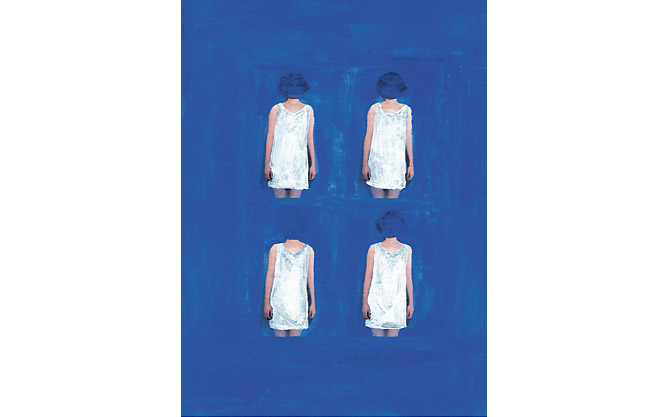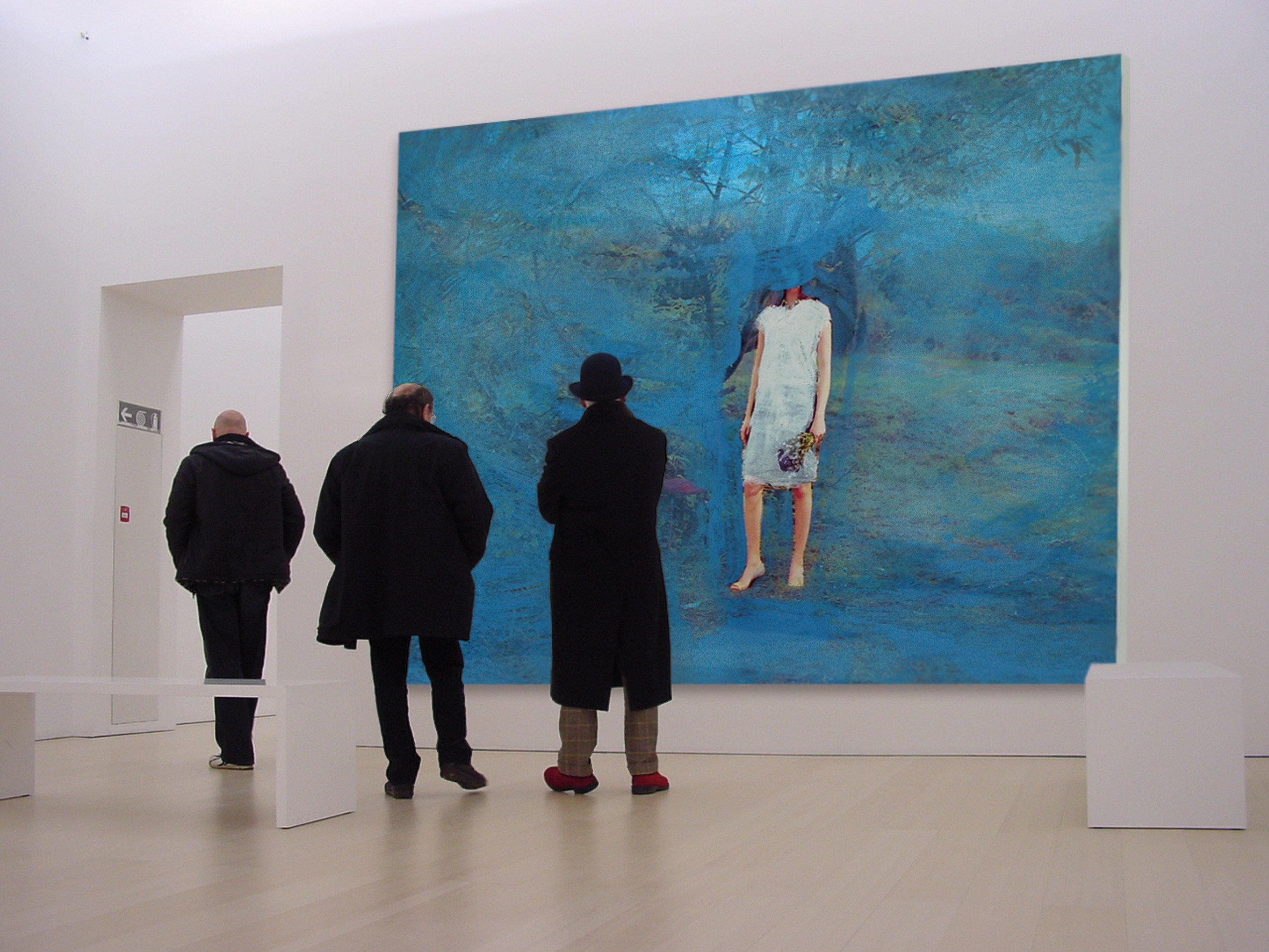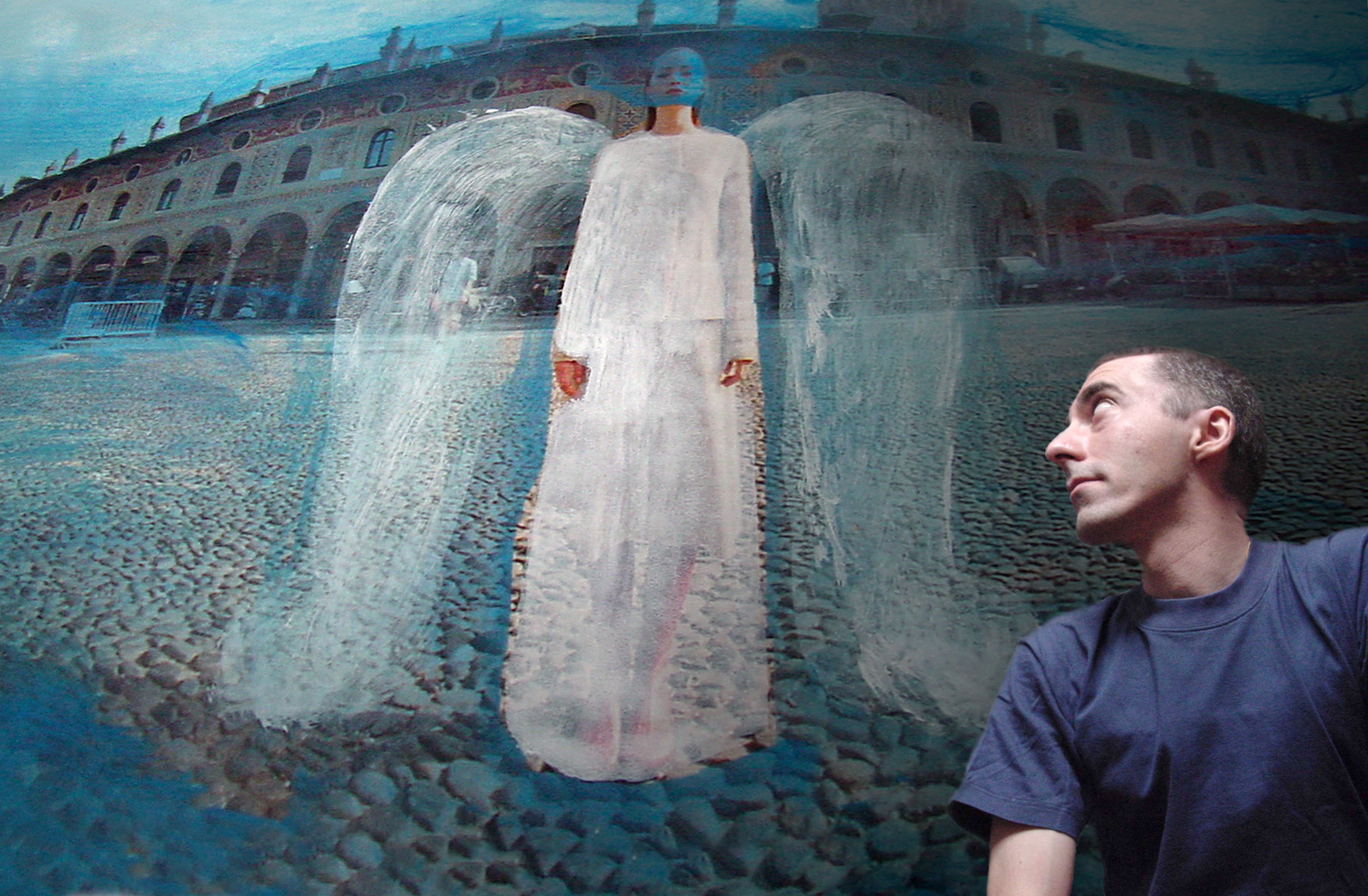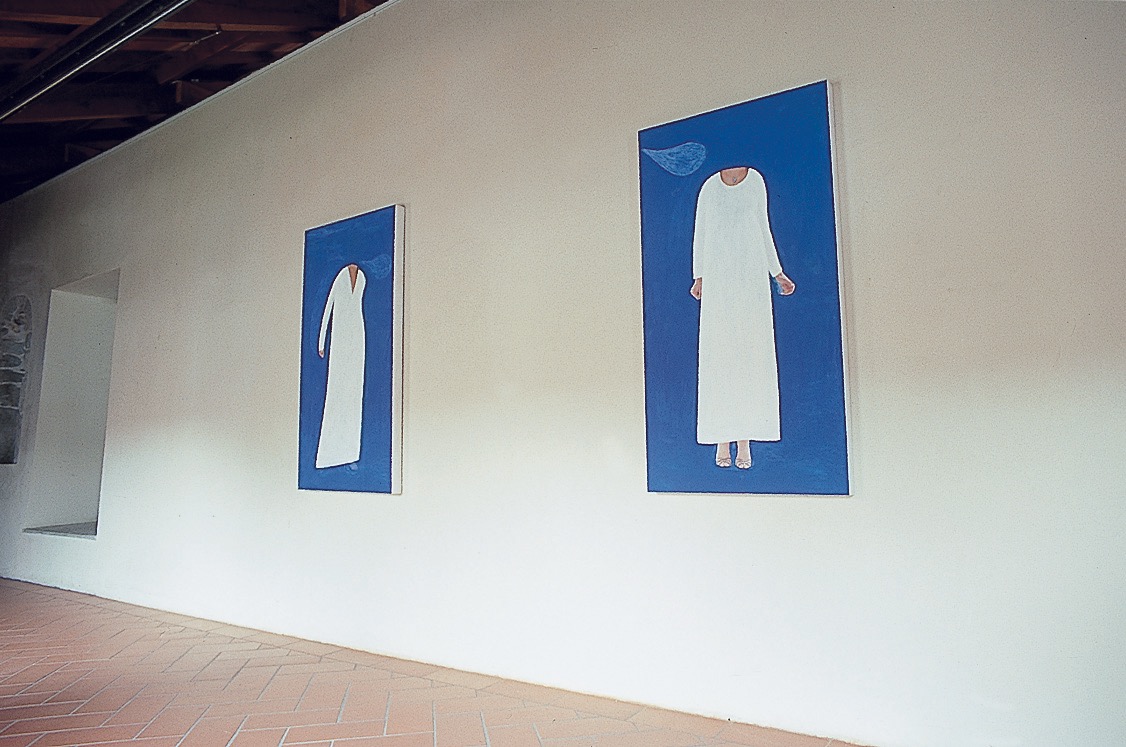Esistenze acefale

di MAURIZIO MEDAGLIA
2006
Un cielo blu che circonda e circola sopra, sotto e intorno a bianchi ectoplasmi di vesti dalle quali fuoriescono frammenti, escrescenze, di carne; un cielo blu, una ghigliottina celeste, che mozza le teste a figure intere tenute insieme, per miracolo o grazia ricevuta, da questo diaccio colore della lontananza, dell’altrove. Presenze acefale o semiacefale di smarriti neurocrani e avanzati splancnocrani. Apparizioni dell’assenza di una identità: dell’assenza di un Io.
Attese, gravidanze, Annunci, Avventi… Angeli e Arcangeli nei titoli di queste tempere acriliche su stampa, su legno, di Riccardo Paracchini. Ma angeli come epifania, rivelazione, d’una crisi d’identità, della crisi di Narciso. O forse l’annuncio mozzafiato che Narciso non è in crisi ma è morto, che l’Io, l’identità, s’è estinta. Che s’è estinto l’Uomo. E che la nostra mente,apparentemente “troppo umana”, è già di un’altra Specie.
C’è qualcosa di terribilmente erotico in queste sfigurate figurine lillipuziane (più swedenborghesi che swedenborghiane…) di Riccardo, in questi suoi angeli e madonnine narcisamente defunti… E questo qualcosa sta in quei lacerti di carni fotografiche strappate alla patina delle riviste, all’immaginario collettivo cosidetto (in fondo all’Io c’è un Noi indiviso, un Noi di estinti Io…).
È qualcosa che ha il sapore e il torpore di quelle erotiche, maliziose e perverse Malinconie dipinte dall’Hayez un secolo e mezzo fa: di quella crisi esistenziale della coscienza contemporanea presentita ed emblematizzata dal pupillo del Canova, in una figura femminile fradicia di eros.
Così come fradice marce e inzuppate di questo cieco eros, imbiancati sepolcri stretti nella morsa del blu, sono le madonne gravide e gli arcangeli annuncianti di Paracchini.
Perché? Perché l’estinzione dell’Io sta producendo un’erotizzazione della esperienza senza eguali; erotizzazione scambiata, da alcuni, per un trionfo di Narciso, mentre in realtà è il segno inequivocabile del suo tonfo di annegato, della catastrofe già avvenuta (beckettianamente) con la di lui morte.
Un’estinzione che (medianicamente) si mostra attraverso questi lavori di Riccardo, mediante l’astanza: ossia sul confine tra presenza e assenza, tra Vivere ed Essere, tra (tecnicamente) la relazione del collage e l’instaurazione pittorica.
“Noi siamo ferocemente religiosi (…). Colui che ignora o misconosce l’estasi è un essere ridotto all’analisi (…). L’uomo è sfuggito alla sua testa, come il condannato alla prigione. Egli ha trovato aldilà di sé stesso non Dio, che è la proibizione del crimine, ma un essere che ignora la proibizione (…). Non è un uomo né tanto meno Dio. Egli non è me, ma è più di me: il suo ventre è il dedalo nel quale egli stesso si è smarrito (…)”. (Georges Bataille, da Acéphale, 1936).
GOOGLE TRANSLATION
Headless existences
A blue sky that surrounds and circulates above, below and around white ectoplasms of clothes from which fragments, excrescences, of flesh emerge; a blue sky, a celestial guillotine, that cuts off the heads of entire figures held together, by miracle or grace received, by this icy color of distance, of elsewhere. Headless or semi-headless presences of lost neurocrania and advanced splanchnocrania. Apparitions of the absence of an identity: of the absence of an Ego.
Expectations, pregnancies, Announcements, Advents… Angels and Archangels in the titles of these acrylic temperas on print, on wood, by Riccardo Paracchini. But angels as epiphany, revelation, of an identity crisis, of the crisis of Narcissus. Or perhaps the breathtaking announcement that Narcissus is not in crisis but is dead, that the Ego, the identity, has become extinct. That Man has become extinct. And that our mind, apparently “too human”, is already of another Species.
There is something terribly erotic in these disfigured Lilliputian figurines (more Swedenbourgeois than Swedenbourgian…) of Riccardo, in these narcissistic angels and Madonnas… And this something is in those scraps of photographic flesh torn from the patina of magazines, from the so-called collective imagination (at the bottom of the Self there is an undivided Us, a Us of extinct Selves…).
It is something that has the flavor and the torpor of those erotic, malicious and perverse Melancholies painted by Hayez a century and a half ago: of that existential crisis of contemporary consciousness foreseen and emblematized by Canova’s pupil, in a female figure soaked in eros.
Just as sodden, rotten and soaked by this blind eros, whitewashed sepulchres gripped in the grip of blue, are Paracchini’s pregnant Madonnas and heralding archangels.
Why? Because the extinction of the Ego is producing an unparalleled eroticization of experience; an eroticization mistaken, by some, for a triumph of Narcissus, while in reality it is the unmistakable sign of his drowning thud, of the catastrophe that has already occurred (Beckettianly) with his death. An extinction that (mediumistically) shows itself through these works by Riccardo, through the absence: that is, on the border between presence and absence, between Living and Being, between (technically) the relationship of the collage and the pictorial establishment.
Altri Testi…


